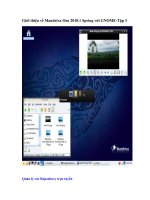resource lks2 science y3 spring 1 rock detectives powerpoint session2 resource
Bạn đang xem bản rút gọn của tài liệu. Xem và tải ngay bản đầy đủ của tài liệu tại đây (933.02 KB, 16 trang )
Science - Year 3
Rocks – Block 3R
Rocks and Fossils
Session 2
Rock Detectives PowerPoint
© Original resource copyright Hamilton Trust, who give permission for it to be adapted as wished by individual users.
We refer you to our warning, at the foot of the block overview, about links to other websites.
Rock Detectives
Clue 1
How hard is the rock?
Some rocks are soft and crumbly whilst others are
very hard and strong
Try a hardness test on your rock samples
•
•
•
•
Can you scratch them with different items?
Which items will scratch them and which will not?
Can you crumble them?
Can you put them in order from the softest to the
hardest?
What will hardness tell you?
Sedimentary rocks are usually a lot softer than
igneous and metamorphic rocks
Clue 2
Will water soak into it?
Try dropping a small amount of water on your rock samples and
watch to see if it soaks in
What will this tell you about your rocks?
If water can soak into a rock
or pass through it, we say it
is a permeable rock.
Sedimentary rocks are
usually permeable.
If water can not soak into a rock, the
rock is said to be impermeable.
Metamorphic and igneous rocks are
often impermeable.
Clue 3
The acid test
Vinegar is an acid. Try dropping a small amount of
vinegar on your rocks. Then look carefully to see if
it fizzes.
What will this tell you about
your rocks?
Remember that sedimentary
rocks can contain the bodies of
sea creatures that died long
ago. Their shells dropped into
the muddy sediment and
became buried. After millions
of years they were turned to
rock.
If a rock was once the shells of
creatures, it will fizz when acid
is dropped onto it.
Some metamorphic rocks will fizz too if they were once sedimentary rocks that
contained shells and were then changed by great heat or pressure.
Clue 4
What is it like close up?
If your rock has stripes or layers it
will probably be a sedimentary
rock
Some landscapes show the layers of sediment that
have turned to rock. You may have seen them at the
seaside.
But some metamorphic rocks
may also have layers if they
used to be sedimentary rocks
but were changed by heat or
pressure!
If your rock has crystals it will probably be an igneous rock or an
igneous rock that has become a metamorphic rock because it has
been changed by heat or pressure.
Rock Scientists (Petrologists) find out about their rock
samples by looking closely at them and by doing tests on
them.
If your teacher gives you a test, they
make it fair by making sure everyone has:
• The same instructions
• The same equipment
• The same length of time to do it
Scientists have to make sure their tests are fair too!
Suppose a scientist decided to test rocks for hardness by
rubbing them on sandpaper. They rubbed one rock 20
times and another 10 times and then compared the
amount of rock dust, would that be fair?
How could they make the test fair?
When you test rocks, you will need to think about
how to make your tests fair!
It’s time to become rock detectives!









